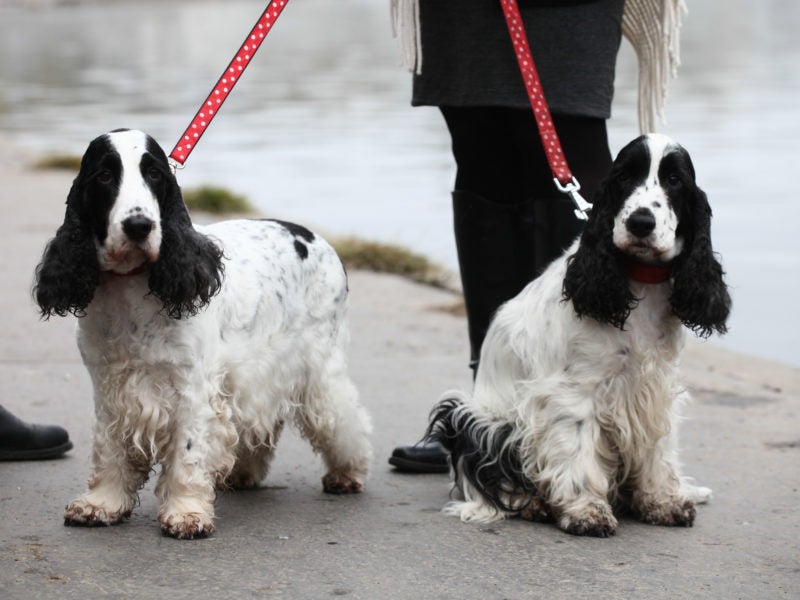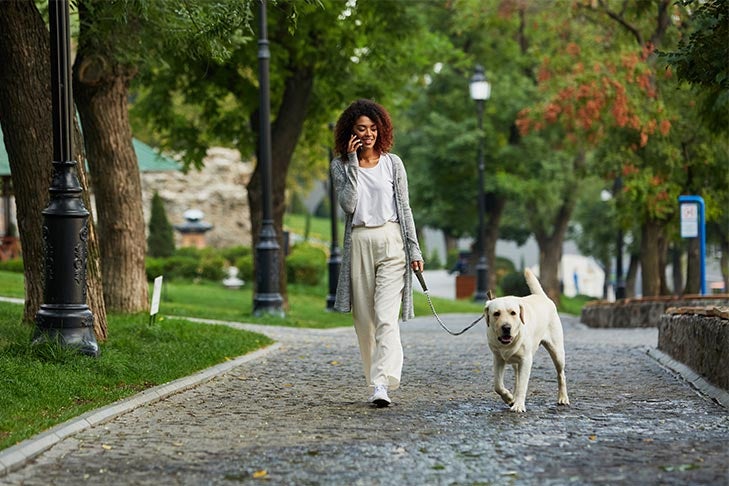
Have you ever felt like you’re doing everything right in training your dog, but he’s not progressing? Sometimes, no matter how good we are at teaching our pups, other forces hinder our success. If your canine companion seems to do well for a bit and then backslides, or a problem behavior doesn’t seem to be going away despite your best efforts, it’s time to investigate why. A good place to start is with others who come into contact with your dog, such as a dog walker.
Consistency is Critical
Your dog walker has your dog’s best interests at heart, but unless she’s aware of your training cues, methods, and the rules you’ve put in place, she can unknowingly undo your hard work. A good example is pulling on the leash. If you’ve been teaching your dog that he can only walk when the leash is slack, and you will stand still whenever he pulls, he should learn that pulling is counterproductive. However, if your dog walker lets your pup take charge and drag her around the block, it can bring you back to square one. These mixed messages will prevent your dog from catching on to your training.
Or maybe you’ve been training your dog to stop jumping up on people, but every time the dog walker comes over, she reacts to his rambunctious greeting with enthusiasm, maybe even encouraging him to put his paws up for an ear scratch. Once again, your training will hit a roadblock.
You simply won’t see progress in your training without consistent rules. Make sure your dog walker understands your training goals and how she can contribute to your dog’s success. And be aware you could run into the same problem with a professional pet sitter, a family member who watches your dog while you’re out of town, or neighborhood kids who run through your backyard. Anybody who interacts with your dog can potentially undo your training efforts. Why? Dogs are always learning, and variable reinforcement is a powerful force.
Dogs Are Always Learning
Even when you aren’t actively training your dog, he’s always learning. Think about all the things he’s figured out on his own, like when you’re about to go out or where the dog treats are kept. That means every interaction teaches him something new regardless of your intentions. And the same is true for his interactions with others.
So, if you’ve decided that your dog is not allowed on the furniture, but other people cuddle him on the couch, what can you expect your dog to learn? How can he understand which of those two things is the rule and which is the exception? It’s understandable that your dog will be confused, and your training will stall. Or if you want your dog to only walk on your left side, but your dog walker lets him wander back and forth, how can he understand which behavior is correct. Both situations are learning opportunities, but more importantly, the one that most gets him what he wants will be the stronger lesson. The cuddle on the couch will have more impact than having to lie on the ground.

Rules of Reinforcement
Dogs learn through reinforcement. In other words, they repeat behaviors that are rewarding. And not only are they always learning, but they are also always looking for a way to get the things they want. When a behavior gets them something good, like the chance to walk outside or your attention, that behavior is reinforced and becomes stronger, making it more likely they’ll do it again. This is what makes positive reinforcement training methods so powerful. It’s also why everyone who interacts with your dog should follow the rules you’ve set.
Take the jumping dog again. Most dogs jump up to greet you face to face. They want your attention. So, to curb the behavior, you stop giving your dog your focus when he jumps up — you turn away from him, maybe even walk away. Then, when he settles down, you immediately give him the attention he craves. The jumping behavior will start to fade out and be replaced by calmer greetings. But then your dog walker comes over and encourages your dog to jump on her, giving him lots of love and “good boys” for his exuberant greeting. That’s reinforcing, but even worse it brings the slot machine effect into play.
The Slot Machine Effect
Slot machines hook people by using a variable reinforcement schedule; you never know when they are going to pay off. Sometimes you get bells and whistles and sometimes you don’t, and there is no way to predict it. In fact, gambling is so enticing because you never know when a reward might be coming. The promise of the next pull being the big winner keeps you trying and trying.
Dogs are equally hooked by variable reinforcement. For behaviors your dog already knows, like jumping or leash pulling, never knowing when a reward is coming actually causes the behavior to get stronger. Your dog knows that at some point he will get rewarded, he just doesn’t know when. So, like the slot machine addict, he ends up using the behavior more and more often, hoping that the next time he’ll hit the jackpot.
You can use this to your advantage when strengthening behaviors. For example, once your dog knows sit, you can reward him at random rather than every time. But on the flip side, variable reinforcement that you don’t control can wreak havoc with your training goals. If your dog is getting occasional reinforcement from the dog walker or pet sitter for behaviors you’ve been trying to eliminate, you will never get them under control.
Backslide Prevention
The good news? It should be relatively easy to keep your dog from becoming confused by the rules and to prevent variable reinforcement from happening. Put everybody on the same page. When it comes to paid professionals or family and friends who watch your dog, give them a list of rules (i.e. he’s allowed on the couch, he’s not allowed to jump up, etc.) and cuesyou use for reinforcement. This will help those interacting with your pup to reinforce the right things and stop them from accidentally rewarding a behavior you are trying to stop.
Mistakes will happen, and that’s okay. But by making sure your dog walker has the necessary knowledge to care for your dog correctly, you can help prevent any backsliding, while still allowing for the pampering your pup deserves. Make your dog walker your training partner and watch your dog succeed.

